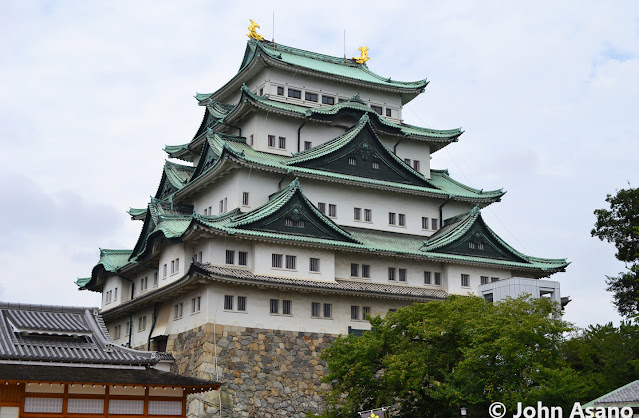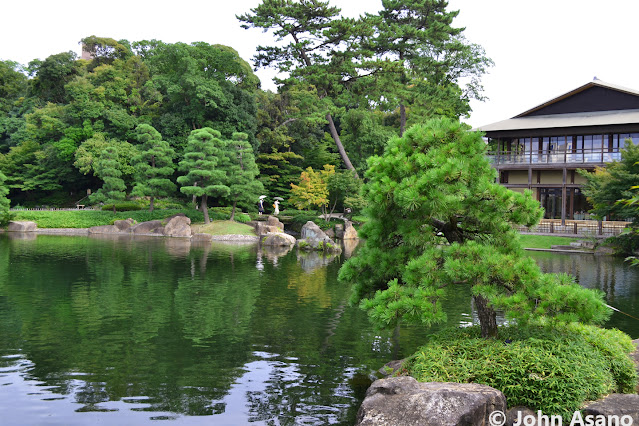Nagoya, the capital of Aichi Prefecture is Japan’s 4th most populated city and is ideally located in the center of Japan making it a transportation hub. It is a fantastic place to base yourself during your travels in Japan as it is easy to hit up on some of the country’s best sightseeing spots with just a day trip.
Recently, I had the chance to head back to Nagoya on Day 3 of the Samurai & Timber Tour organized by the good folks at Nagoya is not boring and Nagoya City. Make sure you read about Day 1 in Gujo Hachiman and Day 2 in Inuyama. The schedule was packed but there were a lot of fun things to do and see in Nagoya.
Nagoya Castle
Nagoya Castle is Nagoya’s most popular tourist destination and a symbol of its status as a samurai city. Back in its heyday, it was the biggest, the best designed, the most gorgeous and the best preserved of all the samurai castles in Japan.
 |
| The southwest corner watchtower |
Nagoya Castle was Japan’s first castle to be designated a National Treasure in 1930. It was completed in 1612 by the Shogun, Tokugawa Ieyasu (1543-1616) to showcase his power and to act as the first line of defense for Edo (Tokyo) against a potential attack from rival Osaka. The Shogun relocated the castle town from nearby Kiyosu, making Nagoya the capital of Owari Domain and one of the most important castle towns in Japan, ultimately growing to become Japan’s fourth largest city. The castle was the seat of the Owari Tokugawa Clan, one of the three branches of the Tokugawa family from which the Shogun could be chosen.
The crafty Ieyasu had the mighty fortress built at next to no personal expense by placing the burden on 20 former enemy warlords, who had to complete the massive construction by sourcing and moving many tons of huge stones and construction materials. Today, you can still see the inscriptions of various daimyo’s family crests in some of the larger stones which clearly indicated where the stones came from. The labour and financial strain, prevented the daimyo from spending on arms, armour and armies, thus weakening them and lessening any potential for rising against him. No wonder the Tokugawa Shogunate lasted for more than 260 years!
 |
| Nagoya Castle and stone wall |
The massive main tower was topped with two golden shachihoko and was Japan’s biggest keep during the Edo period (1603-1868). If you are keen to see the main keep in its current form, hurry as it is scheduled to be demolished and reconstructed in wood in the near future.
 |
| The main tower of Nagoya Castle |
Honmaru Goten Palace
The magnificent Honmaru Goten Palace at Nagoya Castle was considered a masterpiece of Samurai Shoin-zukuri architecture. It was the most elegant, most gorgeous castle palace in all of Japan. The interior of the palace was richly decorated with gold covered walls and screens adorned in stunning works by the leading artists of the day.
 |
| The Taimenjo Reception Hall |
It was built in 1615 to serve as the residence and audience chamber for Tokugawa Ieyasu's 9th son, the first feudal lord of Owari Domain, and later became the accommodation of choice for the Shogun on his rare visits from Edo (Tokyo) to Kyoto. Tokugawa Ieyasu was so impressed with the palace that he ordered a similar palace to be constructed in Kyoto at Nijo Castle.
The Honmaru Palace has been fully restored to look as it did over 400 years ago. The recent rebuild was done using traditional construction materials and techniques and was fully opened to the public in 2018. One of its most spectacular rooms is the Jorakuden Hall, which was a palace for visiting shoguns. It was constructed for the visit of the third Shogun, Iemitsu in 1634. It is the most prestigious building in the Honmaru Palace with richly decorated walls and ceilings, and intricately carved and vividly coloured transoms between the rooms.
 |
| The Jorakuden Hall was used by the Shogun when visiting Nagoya |
Tokugawaen Garden
Tokugawaen Garden was built in 1695 as a retirement villa for Tokugawa Mitsutomo (1625-1700), head of the Owari Tokugawa family, and second lord of Owari Domain. The garden is an oasis in the middle of Nagoya and draws visitors during all seasons to escape the city. It is particularly beautiful during autumn when the Japanese maples are a fiery red. The garden is designed in a style typical of daimyo gardens from the Edo period (1603-1868). Some of the main points of interest in the garden include:
 |
| Tokugawaen Garden |
Ryusen Lake
The center piece for the garden is surrounded by beautiful waterfalls, promenades, bridges, and teahouses. The best way to enjoy the garden is to walk around the lake and take in all the points of interest which are arranged near the water’s edge.
 |
| Ryusen Lake at Tokugawaen Garden |
Ryumon no Taki
A beautiful waterfall based on the legend of a carp that leaped up a waterfall and turned into a dragon.
Zuiryutei (Teahouse)
This small teahouse on a hill overlooking the lake is connected to Oda Urakusai, from my previous article on Inuyama, who was the tea ceremony master for the Owari Tokugawa family.
 |
| Zuiryutei Teahouse |
The Kuromon (Black Gate)
The main gate and entry point into the complex which includes the Tokugawa Art Museum and Tokugawaen Garden. Completed in 1900, the gate is an original that remains from the Owari Tokugawa family residence.
 |
| The Kuromon Black Gate |
Tokugawa Art Museum
The Tokugawa Art Museum houses the magnificent treasures of the Owari Tokugawa Clan, rulers of Nagoya and Owari Domain during the Edo period (1603-1868). The museum located next to Tokugawaen Garden was opened in 1935 and contains more than 10,000 artworks from the Owari Tokugawa family. The collection includes swords and armour from the Tokugawa family as well as cultural items such as tea ceremony utensils, Noh theatre masks, and scrolls including an original of the Tales of Genji.
 |
| One of the treasures at the Tokugawa Art Museum |
The first room houses swords and suits of armour that are displayed as they would have been in a daimyo residence.
 |
| Tokugawa armour in the first room |
 |
| Samurai sword in the first room of the museum |
The impressive Noh theatre is a reproduction of the Noh stage from Nagoya Castle. Noh performances formed an integral part of household ceremonies and entertainment for guests at the castle.
 |
| Noh theatre reproduction from Nagoya Castle |
The most famous of all Japanese handscrolls is the 12th century Tale of Genji. This classic work of Japanese literature was created around the peak of the Heian period in the early 11th century. The museum is home to a rare original copy of this legendary piece of work.
Flat Noodles at Hōsa
Nagoya is also home to some of the best food in Japan and can rival any city in Japan as a foodie destination. One of its most famous local dishes is kishimen (flat noodles). One of the best places to try them is at Hōsa near Nagoya Castle. This new restaurant serves a variety of kishimen noodle dishes as well as a selection of seasonal Japanese sweets in a Wa-modern setting.
 |
| Kishimen noodles at Hōsa |
Suehirodo Nagoya Folding Fan
Nagoya Sensu (Nagoya folding fans) are one of the city’s traditional crafts with a history of more than 300 years. At Suehirodo, visitors can try a folding fan making experience next to none under the guidance of a master craftsman.
Nagoya Sensu was created by Inoue Kanzo and his son, who moved from Kyoto to Nagoya during the mid-18th century to set up shop in what is present day Habashita in Nishi-ku, Nagoya (near Nagoya Castle). Since that time, the industry has been flourishing in Nagoya. Simply made with washi paper on a bamboo frame, the fans bear fine calligraphy and elegant designs.
Participants can draw their own original designs on the washi paper and then assemble and finish off their own personal fan to take home as a souvenir.
 |
| Making a folding fan via Nagoya is not boring |
How to Get to Nagoya
Nagoya is conveniently located along the JR Tokaido Shinkansen route between Tokyo and Kyoto. From Tokyo, it is about 100 minutes on the Nozomi bullet train (¥10,780).
Wrap Up
The next time you are in central Japan, make sure you get off that shinkansen and explore all that Nagoya has to offer.
Remember to read about day 1 of the tour in Gujo Hachiman in Gifu Prefecture and day 2 in Inuyama in Aichi Prefecture. If you want to book your own epic Samurai & Timber tour of Gujo Hachiman, Inuyama and Nagoya, visit the Nagoya is not boring website.
 |
| Nagoya Castle |


Thank you great post. I love Nsgoya but I did not know about the fan making 😀
ReplyDeleteThank you! The folding fan experience was a lot of fun. I highly recommend it.
Delete